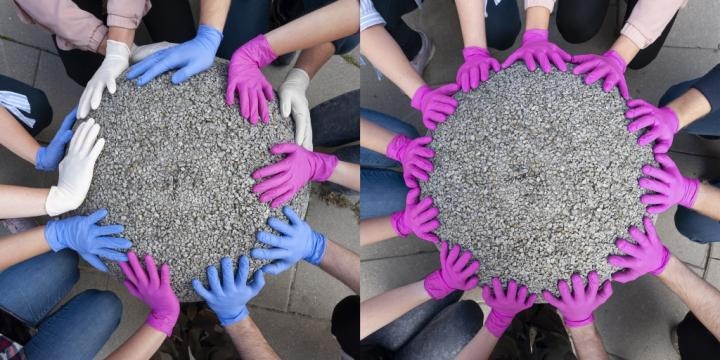Dec 4 2019
Nanocrystalline zinc oxide (ZnO) has exclusive electro-optical and catalytic characteristics. Therefore, it is one of the most widely used semiconductor metal oxide nanomaterials at present.
 Researchers from IPC PAS, WUT, and IRIG compared the structures of the organic layers that stabilize ZnO QDs prepared by both methods (i.e. the commonly used sol-gel method and OSSOM approach developed in Warsaw). We tried to present the essence of our research as (a) chaotically arranged, differently colored hands, which is characteristic for sol-gel derived ZnO QDs, and (b) hands arranged in pairs, very regularly around the core, which is characteristic for ZnO QDs prepared by the OSSOM method. Image Credit: IPC PAS, G. Krzyzewski.
Researchers from IPC PAS, WUT, and IRIG compared the structures of the organic layers that stabilize ZnO QDs prepared by both methods (i.e. the commonly used sol-gel method and OSSOM approach developed in Warsaw). We tried to present the essence of our research as (a) chaotically arranged, differently colored hands, which is characteristic for sol-gel derived ZnO QDs, and (b) hands arranged in pairs, very regularly around the core, which is characteristic for ZnO QDs prepared by the OSSOM method. Image Credit: IPC PAS, G. Krzyzewski.
The unique and intrinsic physicochemical properties of ZnO nanostructures rely on various factors governed by the applied synthetic process and the nature of the ensuing nanocrystal-ligand interface. Hence, it is still very difficult for chemists to prepare stable ZnO nanostructures, specifically nanoparticles with sizes less than 10 nm, that is, quantum dots (QDs), with preferred physicochemical properties.
Researchers from the Institute of Physical Chemistry of the Polish Academy of Sciences (IPC PAS) and Warsaw University of Technology (WUT) collaborated with the Interdisciplinary Research Institute of Grenoble (IRIG) and recently performed in-depth characterization of the organic-inorganic interfaces of ZnO QDs synthesized by the conventional sol-gel process, as well as using the latest one-pot self-supporting organometallic (OSSOM) process.
They achieved this by making use of dynamic nuclear polarization (DNP)-enhanced solid-state nuclear magnetic resonance (NMR) spectroscopy.
Simultaneously, analyses were performed on the design and synthesis of bio-stable ZnO QDs, in addition to determining the relationship between their structure and biological activity. These research works have been published in the high-impact journals Angewandte Chemie and Scientific Reports.
“We wanted to unambiguously confirm that ZnO QDs prepared in our laboratory using the OSSOM approach are of unprecedentedly high quality,” reports Dr Małgorzata Wolska-Pietkiewicz, co-author of both studies.
Up to now, ZnO QDs have been commonly produced by a sol-gel process. However, the main disadvantage of this traditional method is the low reproducibility, which likely inhibits both the uniformity of particle morphology and organic ligand shell composition.
Dr Małgorzata Wolska-Pietkiewicz, Warsaw University of Technology
Consequently, the resulting nanostructures are essentially unstable and tend to aggregate. In my opinion, this has significantly limited potential applications of nanocrystalline ZnO in various technologies,” added Dr Wolska-Pietkiewicz.
“An alternative to the omnipresent sol-gel method are highly promising wet-organometallic approaches. Recently developed in our laboratory, the OSSOM procedure is based on the controlled exposition of a well-defined organozinc precursor to air. The OSSOM process is thermodynamically controlled and occurs at room temperature.”says Professor Janusz Lewiński.
The structures and process-driven characteristics of the organic ligand shells of QDs created by both the OSSOM method and the sol-gel process were compared, to establish the superiority of the organometallic process for preparing ZnO QDs. The researchers performed this by applying the DNP-NMR technique developed by the group of Dr Gaël De Paëpe (IRIG).
“This NMR technique allows us to study nanomaterials’ interfaces with atomic precision and thus to demonstrate the difference between tested materials,” stated Dr Daniel Lee, who added that being able to establish the precise structure and nature of the interface offers a better understanding of future designs for novel and fully stable functional nanomaterials.
Moreover, DNP-NMR measurements are comparatively fast and need only a few hours. In fact, this is not much, specifically compared to traditional NMR spectroscopy, which (in the case of measurements with equivalent resolution) would need about a year.
The OSSOM method leads to the formation of ZnO QDs coated with strongly anchored and highly-ordered organic coatings. Contrastingly, on the surface of sol-gel derived ZnO nanostructures, coating ligand molecules are randomly distributed.
Dr Małgorzata Wolska-Pietkiewicz, Warsaw University of Technology
Not just that, ligands could even be eliminated easily from the surface of QDs prepared by the sol-gel procedure, thereby modifying the characteristics of the resulting nanomaterial. “In our method, the surface is super-protected, and QDs are stable. As a result, the OSSOM approach affords high-quality ZnO QDs with unique physicochemical properties, which are prospective for biological applications,” added Dr Wolska-Pietkiewicz.
Why it is so Important?
This preliminary study has only just scratched the surface (pun intended) of what can be achieved. We have shown that being able to study nanomaterials’ surface stability at an atomic scale enables the understanding of how to provide their stability, which is extremely important from the point of view of subsequent applications: from sensors and optical devices to targeted drug delivery and nanomedicines.
Dr Daniel Lee, Interdisciplinary Research Institute of Grenoble
According to Professor Lewinski, “In the near future, we could design, for example, safe and effective drug nanocarriers for cancer therapies, in which we would be able to deposit appropriately selected, active molecules within our ordered organic layer.”
“Positioning is important especially for targeted therapies, e.g. photodynamic therapy, because it allows the drug to be released evenly in a particular environment and at the right speed. In addition, owing to the achieved ligands ordering, we are able to pack a lot of active drug particles on a small carrier” added Professor Lewinski.